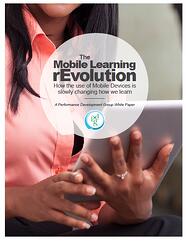The PDG white paper, The Mobile Learning rEvolution, gives an overview of how the use of mobile devices is slowly changing how we learn. Here’s a selection from the white paper.
Mobile devices have become so common that they are part of our learning lexicon whether we like it or not. “Mobile Learning” is a misnomer, as learning style is not unique to a device. However, people have demonstrated clear ways they prefer to use their mobile devices and we would do well to note that and focus our learning design. Mobile devices have unique attributes, or “affordances,” which allow us to do things on mobile devices that would be difficult to do through other methods.
The Mainstreaming of Mobile
A lot of organizations are talking about creating Mobile Learning Strategies. And while innovation is to be applauded, these organizations are really making it more difficult on themselves than they need to. The advent of the iPad and the smartphone haven’t changed the way people learn; they’ve provided new ways to distribute and consume learning.
That’s not to say that people’s expectations for how they learn and how they access information haven’t changed, however. As the smartphone and tablet become parts of everyday life, our expectations have changed.
We tend to consume information:
- Close to the time of need
- In small, easily digestible chunks
- And expect to access it immediately
Mobile devices make it easier to incorporate learning directly into business process, rather than separate from it. When we start to think about Mobile Learning Strategies, it helps if we look at the way people already use their mobile devices. Rather than trying to convince them to use a new method of learning on mobile devices, we need to design learning that leverages the way our learners already prefer to use their devices.
Want to learn more? You can download the white paper here for free! You can also find out more about mobile learning with these resources:
- 12 Tips and Tactics for Creating Effective Mobile Learning
- The iPad Eats the Smartphone and Mobile Learning Becomes Real
- Mobile Learning is SO 10 Minutes Ago…
- New Technology Rollout


 2. Come into the dialogue as an advisor and business partner, not as an order taker. This means coming prepared with information and ideas and then setting expectations and goals.
2. Come into the dialogue as an advisor and business partner, not as an order taker. This means coming prepared with information and ideas and then setting expectations and goals.






 more evident with benefits such as improved: performance; decision making; leadership skills.
more evident with benefits such as improved: performance; decision making; leadership skills.



 I recently attended Performance Development Group’s Performance Consulting Workshop, and found it full of valuable information. I work in a marketing role at PDG, but I thought the information I learned at this workshop would be helpful to our customers and others in the field. So here’s a taste of the insight I gained from the PDG performance consultants.
I recently attended Performance Development Group’s Performance Consulting Workshop, and found it full of valuable information. I work in a marketing role at PDG, but I thought the information I learned at this workshop would be helpful to our customers and others in the field. So here’s a taste of the insight I gained from the PDG performance consultants.
